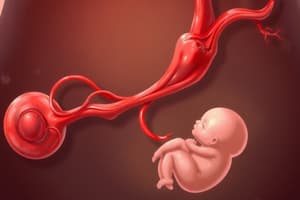Podcast
Questions and Answers
What is the function of the umbilical arteries in fetal circulation?
What is the function of the umbilical arteries in fetal circulation?
- Carry oxygenated blood from the mother to the fetus
- Carry deoxygenated blood from the fetus to the placenta (correct)
- Connect the umbilical vein with the inferior vena cava
- Return oxygen and nutrients to the fetus
Which blood vessel carries oxygenated blood from the mother to the fetus in the umbilical cord?
Which blood vessel carries oxygenated blood from the mother to the fetus in the umbilical cord?
- Foramen ovale
- Ductus venosus
- Umbilical arteries
- Umbilical vein (correct)
What is the role of the ductus venosus in fetal circulation?
What is the role of the ductus venosus in fetal circulation?
- Returns oxygen and nutrients to the fetus
- Carries deoxygenated blood from the fetus to the placenta
- Bypasses the lungs
- Bypasses the liver (correct)
Which structure allows for the most oxygenated blood from the umbilical vein to reach the left ventricle with the least resistance?
Which structure allows for the most oxygenated blood from the umbilical vein to reach the left ventricle with the least resistance?
What is the purpose of the foramen ovale in fetal circulation?
What is the purpose of the foramen ovale in fetal circulation?
What is the function of the ductus venosus in the fetal circulatory system?
What is the function of the ductus venosus in the fetal circulatory system?
How does the foramen ovale close after the baby is born?
How does the foramen ovale close after the baby is born?
What is the role of the umbilical vein in the fetal circulatory system?
What is the role of the umbilical vein in the fetal circulatory system?
Which fetal shunt allows blood to flow from the right atrium to the left atrium?
Which fetal shunt allows blood to flow from the right atrium to the left atrium?
What happens to the ductus venosus after birth?
What happens to the ductus venosus after birth?
Flashcards are hidden until you start studying
Study Notes
Fetal Circulation: Understanding Umbilical Arteries, Umbilical Vein, Ductus Venosus, and Foramen Ovale
The fetal circulatory system is a complex and intricate network that ensures the fetus receives necessary oxygen and nutrients from the mother via the placenta. This system is different from the adult circulatory system in several ways, including the presence of three shunts that bypass the lungs and liver. These shunts are the foramen ovale, ductus arteriosus, and ductus venosus, which play crucial roles in fetal circulation.
Umbilical Arteries
The umbilical arteries are two blood vessels that branch from the umbilical vein within the umbilical cord. They carry deoxygenated blood from the fetus to the placenta, where waste products and carbon dioxide are released into the mother's circulatory system. The placenta then returns oxygen and nutrients to the fetus via the umbilical vein.
Umbilical Vein
The umbilical vein is the largest blood vessel in the umbilical cord. It carries oxygenated blood from the mother's circulatory system to the fetus. Once the baby is born, the umbilical vein closes and becomes the stump of the cord that is later cut and discarded.
Ductus Venosus
The ductus venosus is a fetal shunt that bypasses the liver. It connects the umbilical vein with the inferior vena cava (IVC) and allows for the most oxygenated blood from the umbilical vein to reach the left ventricle with the least resistance. After birth, the ductus venosus usually closes within a few days, and the liver takes over the function of processing blood.
Foramen Ovale
The foramen ovale is another fetal shunt that allows blood to flow from the right atrium to the left atrium. It bypasses the lungs and ensures that deoxygenated blood from the right ventricle is mixed with oxygenated blood in the left atrium. Once the baby takes its first breaths of life, the lungs expand, and the alveoli are cleared of fluid. This increase in lung pressure and decrease in pulmonary pressures help the foramen ovale close, completing the transition from fetal circulation to newborn circulation.
In summary, the fetal circulatory system is a complex network of blood vessels and shunts that ensure the fetus receives the necessary oxygen and nutrients from the mother. The umbilical arteries, umbilical vein, ductus venosus, and foramen ovale are all essential components of this system that play crucial roles in the fetus's development and survival in the womb.
Studying That Suits You
Use AI to generate personalized quizzes and flashcards to suit your learning preferences.




